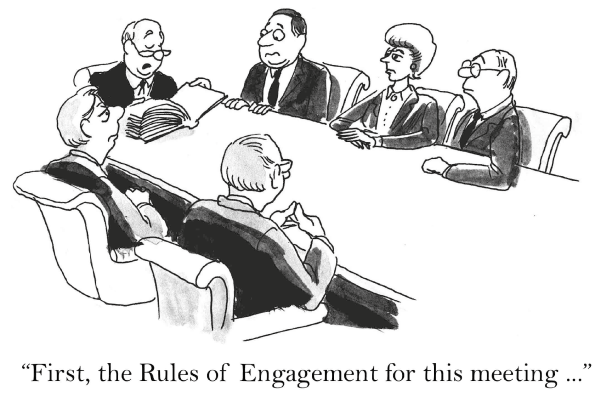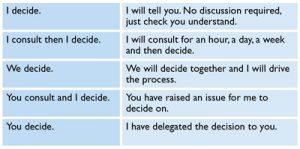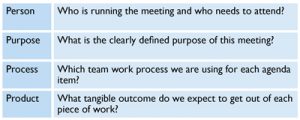Most senior teams only have one or two ways of working together and never learn to vary their approach, based on the needs of the work in front of them. Below, John Sutherland argues that team work is a difference engine and divergence is the fuel.
Tim is in a leadership team but feels torn. He knows it is important to meet but has found that, all too often, little is achieved. He has started writing his emails during the meetings to minimise wasted time. No one has complained because his fellow team members also think their meetings are non-productive. Their in-joke is that they swung between the 4 T’s: Tedious, Time consuming, Tense and Territorial. They were certainly meeting their expectations because their expectations were very low, and had been for years. Sounds familiar?
Meetings are the butt of many a joke and often fall into disrepair or neglect. In fact, many senior teams have stopped holding team work sessions altogether because they could not make them effective. Avoiding meetings, however, just hides the issue and resolves nothing. If you need to get your meetings back on track here are the five factors that I have found to be the most powerful, over my 25 years working with senior teams. What works for you in your business may, of course, be different. There is no one rule book that applies to all organisations.
1.Coherence
Everything starts with coherence. But what does that mean? Sounds like one of those words you get a triple-bonus score for on BS bingo. It means that no matter who you ask, or how you ask, you get a consistent message about what your organisation is focussed on. As an analogy, a light bulb works by scattering energy around the room. Take the same amount of energy and focus it in a straight line and you end up with a powerful laser that can punch a hole through the wall. That is coherence. Which is your organisation more like, the light bulb or the laser? When I run management due diligence assignments for investment companies the first thing I look for is coherence. You need to be able to punch a hole to grow market share.
Once you are clearly focussed (and in my experience most organisations are not, even though they claim they are) you can then ask the simple business question: what do we most need to focus on in our meetings in order to move the dial on performance? The linked, but equally important, question is what do we need to stop spending time on? What needs to go off the agenda that has been clogging up our meeting time but not creating traction?
2. Decisions
The second thing I look for in our management due diligence work is the decision making capability of the senior team. Do they evidence an ability to take the tricky decisions and abide by them? Or do they have a ‘car park’ full of unresolved decisions they keep on recycling? Decisions are one of the key ‘products’ from team work but most teams are poor at the decision making discipline. Why?
Here is a clue. Decisions can be viewed as falling into one of five logical categories, as seen from the view-point of the team leader.
In practice, most leaders have a ‘home style’, usually either ‘I decide’ or ‘we decide’. The ‘I decide’ leaders do not involve people enough. The ‘we decide’ people do not lead enough. So what is your home style? It helps to know. The first task for a team leader is to match the decision making process to the needs of the current business issue. Some issues are not suited to collective decision making, such as bonus payments. Others require multiple input, such as strategic debate.
The second task is to ensure that team colleagues know which process you have selected. Much time is wasted, and much frustration is generated, by a mismatch of expectations about which decision making process is being used. For example, if you have chosen ‘I decide’ but your team think it is a ‘we decide’ issue the debate is likely to rumble on. Whichever process you choose, once you have reached a decision, do yourself a favour and write it down where all can see. You have not agreed until you know that you all mean the same thing by the same words. It saves a lot of time later to take an extra two minutes to check for real understanding.
3. Sutherland’s 4 P’s
To be effective and efficient every meeting needs to be clear about the 4 P’s.
There always needs to be a clearly identified leader for team work. Knowing who it is, especially when the baton passes between people on different items, helps to maintain progress. It is this person who has to make sure that the right items are on the agenda and the wrong ones are taken off. It is also their job to ensure that only the people who need to be there to make progress attend.
Here’s a funny thing. Most senior teams only have one or two ways of working together and never learn to vary their approach, based on the needs of the work in front of them. I worked with one leadership team, in the finance sector, for whom every bit of team work was based on the ’straw man’ process. One unfortunate partner was selected to present a positioning paper and the other five partners took in turns to rip it apart. Unsurprisingly, team morale was dreadful and the weekly meetings were avoided at the slightest excuse.
Team work can be focussed on providing clear direction, sharing information, making a decision, reviewing progress on projects, checking operational reports for strategic implications, considering an options paper or kicking-back for wider strategic debate, and more besides. Each of these have their own process. Decision making, for example, needs to focus down to reach a conclusion. Strategic dialogue needs to open up for wider debate. Most team meetings I sit in on are comprised of a mind-numbing round of individual operational reports that take up 90% of the available time. Simply using exception reporting can reduce the time taken drastically, leaving space for other important team work tasks. If you do not vary your team work processes to match the needs of each agenda item you are not being effective.
But what about the product? If you cannot identify a tangible outcome from the meeting why are you planning one? Agreeing the budget, deciding on project stage gates, running scenario planning, and acting on the strategic implications from the operational reports are all examples of ‘products’ from team-work. Getting to the end of the planned agenda is not an outcome. Just a relief.
4. Core approach
What is your core approach to business? At the senior team level it typically falls into one of the four quadrants, shown in the diagram. You can be strategic or operational and you can be linear or iterative. Linear means working in a structured step-by-step manner. Iterative means refining the process through repeated cycles of exploration. Many teams get into difficulties because those who are operational and linear view those who are strategic and iterative as “fluffy” and wasting time. And those in the strategic-iterative quadrant view their operational-linear colleagues as “luddites” who are stuck in the day-to-day. It is easy to fall into the dangerous trap of believing that your approach is the way everyone else should work.
Try this thought experiment. Firstly, identify which quadrant you spend the majority of time in. Now think of the person in your team you fall out with most often and identify where they usually sit in the quadrant. Chances are they are in a different section, and this is likely to be a key component of the tension between you.
Which quadrant does your team need to be in, in order to be successful with your business plan? It is a trick question, of course. You almost certainly need to use all four quadrants. Getting them to work well together is the issue. Many global organisations exhibit the classic tension between regional business managers, focussed on the linear current operational needs of clients, versus corporate directors, focussed on iterative future strategic development. By contrast, I am working with a great business in Bergen, Norway. Their vision is broken down into key strategic drivers and balanced score cards (linear) and is refined through a regular rhythm of strategic process meetings (iterative). Their process intentionally goes through all four quadrants in a planned and cohesive way. Their business has doubled its revenues this year.
5. Team work is a difference engine
The foundation for effective team work is strong-minded individual leaders. Contrary to the “bumper sticker” slogan that “there is no i in team” the complete opposite is the case. The pre-requisites for productive team debate are coherent focus and clear leaders who are willing to articulate their divergent views, strongly if need be. Team work is a difference engine and divergence is the fuel. To ensure you reach robust outcomes that deliver results, it is imperative to actively seek the differences between individual team members’ positions. There is no collaboration (collaboration = deciding together) unless you have people who can think independently.
You can only have effective debate if each person arrives at the team session having already established their autonomous view (autonomy = deciding for yourself). But if your meetings are viewed as being a waste of time the chances are that, like Tim, you and your colleagues will turn up without having done the preparation work required to make the meeting effective. Especially if, like most businesses, you do not send an agenda out before the meeting.
Try this experiment at your next team meeting. Ahead of a key item give everyone ten minutes to think through their autonomous position, before engaging team debate. Then actively identify the areas of fundamental difference between each team member’s initial position. Go for conflict rather than avoiding it and be cautious of early claims that “we are all really saying the same thing just in different words”. Chances are you are using similar words to mean something quite different from each other. Teams that fuel the difference engine go faster and further.
So what about Tim? He is not the team leader but has decided that every time he feels frustration welling up in a meeting he is going to work on one of these five factors. The great thing about Tim is that when he is frustrated everyone knows about it. Go Tim.
What about you? What are your expectations about the productiveness of your meetings and what are you going to do about it? The ball is in your court.
About the Author
John Sutherland runs the Leadership Initiative, focussed on providing businesses with the specific individual, team and organisational leadership skills required for success with their business plan. He also leads Strategic Resource, a provider of management due diligence services. Contact john@leadership-initiative.co.uk +44 15394 66000











